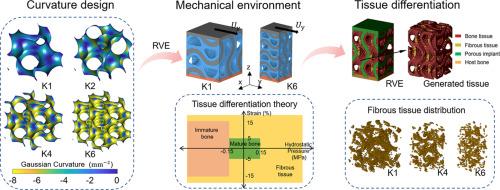多孔种植体骨-种植界面高斯曲率-力学环境-组织再生关系的模拟研究
IF 2.3
4区 医学
Q3 ENGINEERING, BIOMEDICAL
引用次数: 0
摘要
曲率驱动的结构设计正在成为骨修复材料的一个有前途的范例。来自动物研究的实验证据表明,负曲率有助于协调细胞增殖和组织生长,但潜在的机械机制尚不清楚。本研究旨在利用计算方法探讨多孔植入体的曲率设计、力学环境和组织再生之间的关系。设计4个高斯曲率在-1 ~ -6范围内的样本(K1 ~ K6),通过计算模型评估其对组织分化和质量传递的影响。结果表明,更大的曲率(K6)有效地抑制了纤维组织的形成,从而为骨组织留下了更多的空间,这与动物实验的结果一致,动物实验中组织分化主要受应变水平的影响。此外,曲率设计还伴随着孔径的变化。该研究表明,较小的孔隙固有地创造了微力学环境,促进了组织分化,而较大的孔径增强了质量运输,促进了长期骨再生。上述矛盾表明,最佳高斯曲率可以通过平衡机械刺激和质量传输能力来实现,为骨植入物的设计提供了新的范式。本文章由计算机程序翻译,如有差异,请以英文原文为准。

Gaussian curvature-mechanical environment-tissue regeneration relationships at the bone-implant interface of porous implants: a simulation study
Curvature-driven structural design is emerging as a promising paradigm for bone repair materials. Experimental evidence from animal studies suggests that negative curvature facilitates orchestrate cell proliferation and tissue growth, but the underlying mechanical mechanisms remain unclear. This study aimed to explore the relationships between curvature design, mechanical environment, and tissue regeneration in porous implants using computational methods. Four samples with Gaussian curvature ranging from -1 to -6 were designed (referred to as K1 to K6), and their effects on tissue differentiation and mass transport were evaluated through computational models. The results showed that greater curvature (K6) effectively inhibited the formation of fibrous tissue, thereby leaving more space for bone tissue, which is consistent with the results of animal experiments, where tissue differentiation was primarily influenced by strain levels. In addition, curvature design was accompanied by changes in pore diameter. This study revealed that smaller pores inherently created micro-mechanical environments that improved tissue differentiation, while larger pore diameters enhanced mass transport, promoting long-term bone regeneration. The above contradiction implies that optimal Gaussian curvature can be achieved by balancing mechanical stimulation with mass transport capacity, offering a new paradigm for the design of bone implants.
求助全文
通过发布文献求助,成功后即可免费获取论文全文。
去求助
来源期刊

Medical Engineering & Physics
工程技术-工程:生物医学
CiteScore
4.30
自引率
4.50%
发文量
172
审稿时长
3.0 months
期刊介绍:
Medical Engineering & Physics provides a forum for the publication of the latest developments in biomedical engineering, and reflects the essential multidisciplinary nature of the subject. The journal publishes in-depth critical reviews, scientific papers and technical notes. Our focus encompasses the application of the basic principles of physics and engineering to the development of medical devices and technology, with the ultimate aim of producing improvements in the quality of health care.Topics covered include biomechanics, biomaterials, mechanobiology, rehabilitation engineering, biomedical signal processing and medical device development. Medical Engineering & Physics aims to keep both engineers and clinicians abreast of the latest applications of technology to health care.
 求助内容:
求助内容: 应助结果提醒方式:
应助结果提醒方式:


